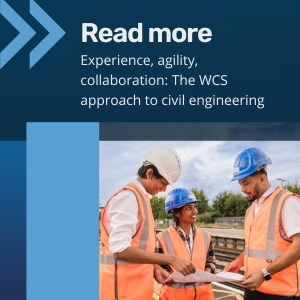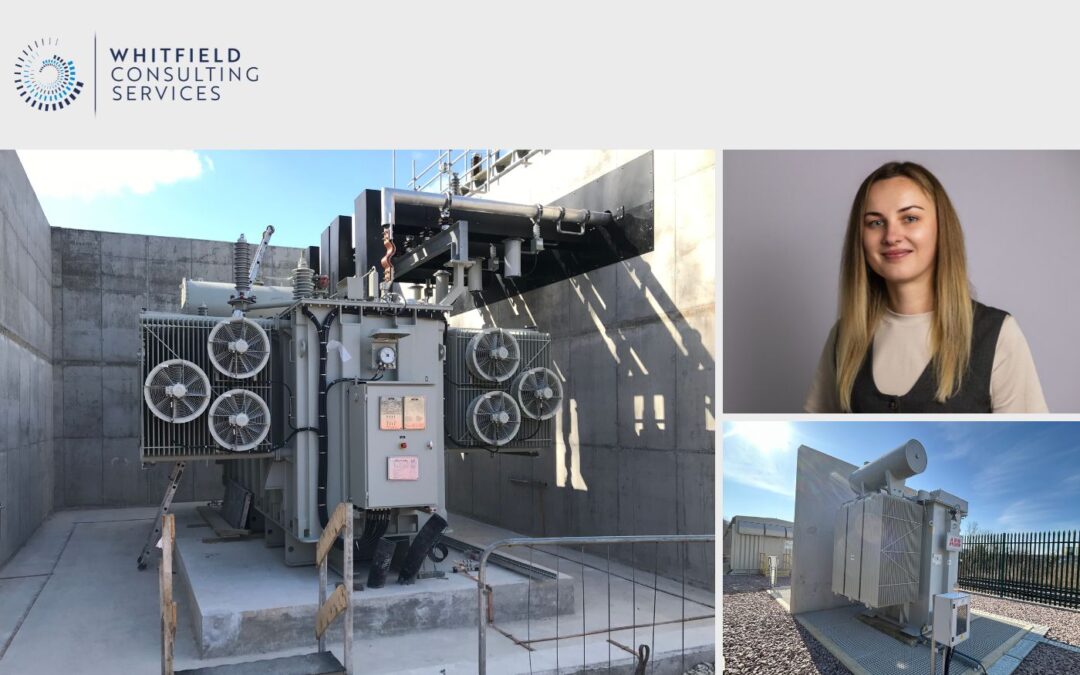High-voltage substations within the UK and Ireland’s transmission network rely on robust design to manage inherent fire risks, particularly those associated with oil-filled transformers and their insulating fluids. Fault-induced fires can threaten personnel safety, damage critical assets, and disrupt regional power supply.
Firewalls are a fundamental component of substation fire mitigation strategies. Their effective design and implementation require civil engineers to navigate regulatory requirements, site-specific constraints, and complex structural demands.
This article examines the technical considerations behind firewall design and installation, highlighting the role civil engineers play in maintaining compliance, ensuring operational resilience, and safeguarding vital energy infrastructure — a process that WCS supports through its experience and collaborative approach.
Why firewall protection matters
Transformers typically contain large volumes of insulating oil, which under fault conditions can become a significant fire hazard. Arcing inside a transformer can heat the oil to several hundred degrees, generating flammable gases such as hydrogen and acetylene. If the fault ruptures the tank and these gases ignite, the result can be an explosion followed by an oil-fed fire.
Without adequate fire protection measures in place, fires can rapidly spread through a substation. A single incident can disable multiple transformers, cripple an entire grid supply point, and endanger lives. The Heathrow Airport outage in March this year illustrated this reality: a fire resulted in a power outage that left Europe’s busiest airport offline for hours, affecting more than 270,000 journeys and costing the airport tens of millions of pounds. Such incidents expose operators to severe financial, operational, and reputational consequences.
Firewalls are designed to delay the spread of heat, flames, and debris from a faulted unit, helping to protect adjacent equipment and maintain substation operability. While they do not provide indefinite containment, British and client-specific standards typically require a fire resistance rating of at least four hours, allowing time for safe evacuation and emergency response.
What makes firewall design complex
Designing and constructing substation firewalls involves several important considerations. It is always an exercise in precision engineering, regulatory compliance, and creative problem-solving.
The complexity arises from several factors:
- Space constraints: Many projects involve retrofitting firewalls within operational substations where clearance margins are tight. Civil engineers must maintain safe access for maintenance and emergency egress while ensuring compliance with minimum separation distances as defined by National Grid standards if not those specific to the client DNO. These often severely restrict the available space for other critical substation elements such as cable troughs and overhead equipment foundations.
- Load and stability: Firewalls must resist not only fire but also factors such as wind loads and potential overpressure forces. Their foundations must suit site-specific ground conditions and accommodate future modifications. The walls and their foundations may also need to be integrated with or separated from the foundation bund of the transformer itself, adding challenges of constructability and structural performance.
- Access for installation: Restricted sites often limit crane access, influencing whether precast or in-situ construction is viable.
- Transformer characteristics: Factors like the transformer’s size, capacity, and location impact the design and installation of firewalls. A higher capacity, such as transformers with large volumes of oil, generates more heat and increases the fire risk, requiring more stringent fire protection measures.
- Material selection: Durability, fire resistance, and compatibility with existing infrastructure are critical. Options include in-situ reinforced concrete, prestressed precast concrete, masonry, andsteel composite panels on structural steel frames. Selection depends on access, lifting capacity, cost, and client standards.
The civil design engineer’s role
“Our responsibility is to design a firewall that performs under the most adverse conditions while fitting within the physical and operational constraints of the site,” explains Dr Natalja Petkune, Director at WCS. “That means considering everything from accessibility and soil conditions to escape routes and long-term maintenance.”
Natalja emphasises the collaborative nature of these projects. “You need input from electrical, fire engineers and construction professionals throughout. Each brings a piece of the picture.”
“Firewalls touch on every aspect of substation design – from layout planning to cable routing, crane positioning, and even future maintenance. You need a team that listens to each other, flags issues early, and adapts together,” adds Natalja.
Firewall design is governed by a range of standards. These include British Standards, industry codes such as EN 6936-1, and utility-specific specifications.
WCS’s track record spans both open-air and enclosed substations across the UK, including work for UK Power Networks, National Grid and Scottish and Southern Electricity Networks (SSEN). The team brings a detailed understanding of each client’s requirements and the practical realities of substation construction.
The WCS approach
Firewall protection safeguards life, prevents catastrophic outages, and protects critical assets. Delivering that protection calls for an engineering design approach grounded in experience, an understanding of operational constraints, and rigorous attention to detail.
“With experienced engineers and extensive industry knowledge, our team excels in designing fire protection systems that meet regulatory and safety standards,” says Dr Natalja.
“We can navigate site-specific challenges effectively, including access restrictions, soil conditions, and material selection, to deliver optimal firewall solutions. Our expertise in customisation, cost management, and timely execution ensures practical, cost-effective, and high-quality outcomes.”
Firewall protection is key to keeping the UK and Ireland’s critical infrastructure running safely – and it takes civil design engineers who understand both regulation and reality to make that happen.
WCS is proud to support the projects that are powering the UK’s transition to renewable energy. See our downloadable case study brochure for the Power & Energy sector. Plus read part one and part two of our recent projects won series, including our work on London Power Tunnels 2.
To find out more about our Power & Energy experience, click here. Or, if you would like to discuss your next project, please get in touch by emailing info@wcs-consult.co.uk or calling +44(0)20 3581 7847.

